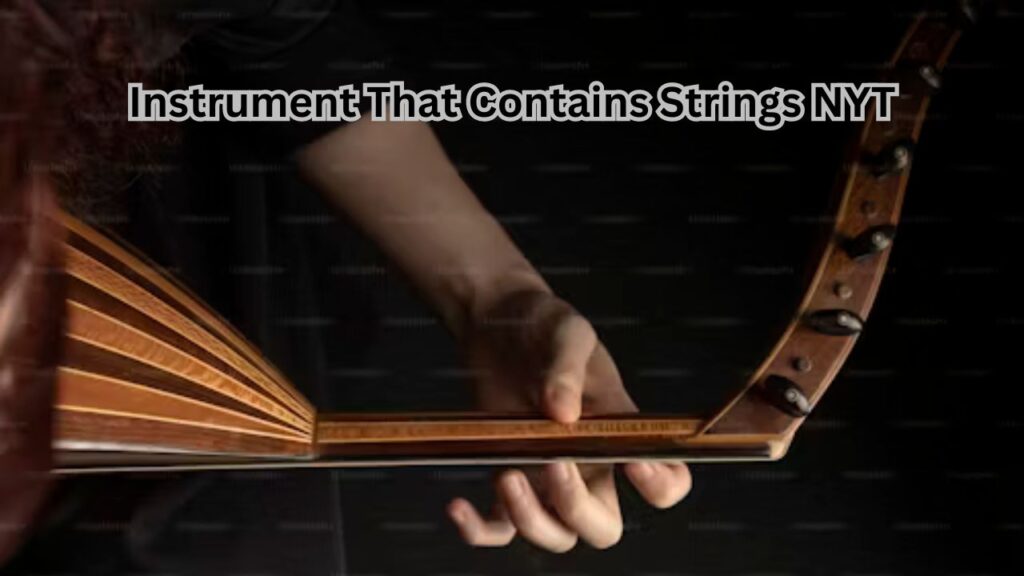Introduction To Instrument That Contains Strings NYT
String Instrument That Contains Strings NYT have played a pivotal role in music across cultures and centuries. These instruments, defined by their use of strings to produce sound, encompass a wide range of types and styles. Recently featured in the New York Times, the story of string instruments is rich with historical depth, cultural significance, and evolving artistry. This article delves into the fascinating world of string instruments, exploring their origins, varieties, and enduring impact on music and culture.
Instrument That Contains Strings NYT: An Overview
The Evolution of String Instruments
String instruments have evolved over thousands of years, with early versions dating back to ancient civilizations. The New York Times article highlights the progression from rudimentary stringed devices to the sophisticated instruments we know today. This evolution reflects technological advancements and changing musical tastes throughout history.
The Anatomy of String Instruments
At their core, string instruments produce sound through the vibration of strings, which can be plucked, bowed, or struck. Common components include:
- Strings: Made of various materials such as gut, metal, or synthetic fibers.
- Body: The resonating chamber that amplifies the sound.
- Neck: Found in many string instruments, supporting the strings and allowing for pitch variation.
- Bridge: Transfers vibrations from the strings to the body.
Also Read : The Evolution of USDTCCK: Past, Present, and Future
Types of String Instruments
Plucked String Instruments
Plucked string instruments are played by plucking the strings with fingers or a plectrum. Key examples include:
- Guitar: One of the most popular string instruments, used in various genres from classical to rock.
- Harp: Known for its ethereal sound, the harp is a staple in orchestras and folk music.
- Mandolin: A small, lute-like instrument often used in bluegrass and folk music.
Bowed String Instruments
Bowed string instruments are played by drawing a bow across the strings. Key examples include:
- Violin: The smallest and highest-pitched member of the string family, essential in orchestras and solo performances.
- Viola: Slightly larger than the violin, with a deeper, richer sound.
- Cello: Known for its wide range and emotive sound, the cello is a cornerstone of classical music.
- Double Bass: The largest and lowest-pitched string instrument, providing the foundation in orchestras and jazz bands.
Struck String Instrument That Contains Strings NYT
Struck string instruments produce sound by striking the strings with hammers or other devices. Key examples include:
- Piano: A versatile instrument used in nearly every musical genre, where hammers strike the strings when keys are pressed.
- Dulcimer: A folk instrument where strings are struck with small hammers, producing a delicate, resonant sound.
Historical Context and Cultural Significance
Ancient Origins
String instruments have ancient roots, with early examples found in Mesopotamia, Egypt, and Greece. These instruments often had symbolic and ceremonial roles, reflecting their importance in ancient cultures. The New York Times highlights discoveries of ancient harps and lyres, underscoring their historical significance.
Renaissance and Baroque Periods
The Renaissance and Baroque periods saw significant developments in string instruments, with advancements in design and construction leading to the creation of many instruments still used today. Composers like Bach and Vivaldi wrote extensively for string ensembles, elevating the status of these instruments in classical music.
Modern Innovations
In the modern era, string instruments have continued to evolve, with innovations in materials and electronic amplification expanding their capabilities. The electric guitar, for instance, revolutionized music in the 20th century, becoming central to genres like rock and jazz.
String Instruments in Contemporary Music
Classical and Orchestral Music
String instruments are fundamental to classical music, forming the backbone of orchestras. Pieces like Beethoven’s symphonies and Tchaikovsky’s concertos showcase the expressive power and versatility of strings.
Folk and Traditional Music
In folk and traditional music, string instruments play a crucial role in conveying cultural heritage. Instruments like the banjo in American bluegrass or the sitar in Indian classical music highlight the diversity of stringed instruments across cultures.
Popular and Modern Music
String instruments have also found a prominent place in popular and modern music. The guitar is ubiquitous in genres like rock, pop, and blues, while the violin adds a unique texture to genres ranging from country to electronic music.
Learning and Mastering String Instruments
Techniques and Skills
Mastering a string instrument requires dedication and practice. Key techniques include:
- Finger Placement: Essential for accurate pitch and intonation.
- Bow Control: For bowed instruments, controlling the bow’s speed and pressure is crucial for sound quality.
- Plucking Techniques: For plucked instruments, different plucking styles can produce a variety of tones.
Educational Resources
There are numerous resources available for learning string instruments, from private lessons and music schools to online tutorials and instructional books. The New York Times article suggests that access to quality education is vital for developing proficiency.
Practice and Persistence
Consistent practice is key to mastering any string instrument. Setting goals, maintaining a practice schedule, and seeking feedback from teachers or peers can significantly enhance progress.
The Future of String Instruments
Technological Advancements
Technology continues to shape the future of string instruments. Innovations like electric violins, MIDI guitars, and digital effects expand the creative possibilities for musicians.
Cultural Integration
As global cultures continue to intersect, string instruments from different traditions are increasingly blending in innovative ways. This fusion creates new genres and enriches the global music landscape.
Sustainability and Craftsmanship
The sustainability of materials and the craftsmanship involved in making string instruments are becoming more important. Efforts to use sustainable woods and ethical practices in instrument making reflect a growing awareness of environmental and social responsibility.
Conclusion
String instruments, with their rich history and diverse forms, continue to be a central part of music across cultures and genres. As highlighted by the New York Times, these instruments are not only tools for musical expression but also symbols of cultural heritage and innovation. Whether you are a musician, a music enthusiast, or simply curious about the world of string instruments, understanding their significance enhances our appreciation for the art of music.
Also Read : Crypto Bastion 25mshenbloomberg: A Comprehensive Guide
FAQs
What are string instruments?
String instruments are musical instruments that produce sound through the vibration of strings, which can be plucked, bowed, or struck.
What are some examples of plucked string instruments?
Examples include the guitar, harp, and mandolin.
What is the significance of string instruments in classical music?
String instruments form the backbone of orchestras and are essential in classical compositions, providing a wide range of expressive capabilities.
How have string instruments evolved over time?
They have evolved from ancient rudimentary forms to sophisticated modern instruments through advancements in design, materials, and technology.
What role do string instruments play in folk music?
String instruments are integral to folk music, reflecting cultural heritage and traditions through their unique sounds and playing styles.
How can one learn to play a string instrument?
Learning involves techniques such as finger placement and bow control, with resources available through private lessons, music schools, and online tutorials.



